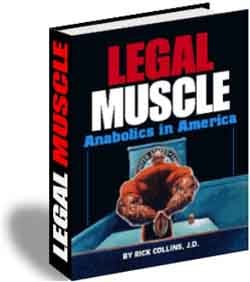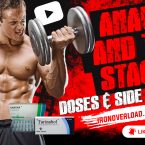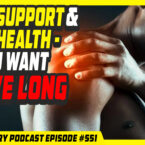Sign up to Get FREE Steroids, SARMS, Peptides eBooks
Mois dernier, Rick Collins, the nation\'s foremost legal authority on anabolic steroids, testified before the United States Sentencing Commission (USSC) on behalf of the National Association of Criminal Defense Lawyers. The USSC had sought comments on whether federal anabolic steroid offenses should be treated with stiffer punishments, such as by changing the way steroid quantities are calculated. Rick submitted the following written testimony. He also offered more extensive oral testimony on a variety of additional points, including the fact that many of the products now classified as "anabolic steroids" were sold to health-conscious consumers nationwide as dietary supplements just months ago. As a result of the testimony, the Commission voted not to increase steroid penalties at this time, instead requesting more time to study the complexities of the issue.
 Arrested, investigated, or charged with a crime related to anabolic steroids? EliteFitness.com recommends Rick Collins as the nation\'s foremost legal authority on anabolic steroids. He handles sports doping cases involving both amateur and professional athletes, and specializes in the defense against steroid possession, importation or sale prosecutions brought in state or federal criminal courts.
Arrested, investigated, or charged with a crime related to anabolic steroids? EliteFitness.com recommends Rick Collins as the nation\'s foremost legal authority on anabolic steroids. He handles sports doping cases involving both amateur and professional athletes, and specializes in the defense against steroid possession, importation or sale prosecutions brought in state or federal criminal courts.
Rick Collins\' book, Muscle juridique: Anabolics in America, sets the new "gold standard" for sports drug reference manuals. It is the ultimate resource, covering all aspects of non-medical anabolic steroid use under American law. It\'s essential reading for natural and "juiced" athletes alike, and for coaches, sports trainers, physicians, journalists and anyone in the criminal justice system. [Here\'s a link to learn more...]
Testimony to the United States Sentencing Commission (Washington, DC; Avril 12, 2005) by Rick Collins JD
As a life member of the National Association of Criminal Defense Lawyers and on the association’s behalf, I wish to thank the Commission for the opportunity to offer my commentary. The subject of anabolic steroids has received massive media attention lately, as well as new attention from Congress. toutefois, much of the attention has been extremely limited in focus. I would like to offer some observations of illicit steroid use outside of professional baseball. I believe that these observations are relevant to the determination of how to implement the directive to this Commission set forth in Section 3 of the Anabolic Steroid Control Act of 2004. En particulier, I will focus on the equivalency of steroids to other Schedule III drugs, and to controlled substances in general.
My comments are offered on behalf of NACDL based upon my "in the trenches" experiences in dealing with anabolic steroid criminal matters. Following a five year stint as a state court prosecutor in the 1980s, I entered private practice focusing on the typical variety of criminal defense matters. Over the last five years, toutefois, my practice has shifted toward a niche practice centering on civil and criminal matters involving steroids and sports supplement matters. I represent and advise several non-profit organizations in the field of bodybuilding, health and fitness, including one with 173 affiliated national federations. Hundreds of matters involving anabolic steroids and related issues have crossed my desk, affording me a unique and extensive view of the intersection of nonmedical steroid use and the criminal justice system in this country. I have attached a copy of my curriculum vitae for your reference. I hope that my practical experience in dealing with steroid cases of all types will be helpful to this Commission on the issue of drug equivalency.
Anabolic Steroids Are Different from Other Controlled Substances
At the outset, the Commission should consider that illicit steroid users are profoundly different from other illicit drug users, and a number of their differences bear upon the issue of equivalency. There is a stark contrast between the profiles, motivations, and patterns of possession and use of illicit steroid users and that of persons who use other drugs. En effet, steroids themselves are different from other controlled substances.
Anabolic steroids are the only hormones in the entire Controlled Substances Act, et la testostérone, the criminalized steroid by which all others are measured, is naturally present in the bodies of every American man, woman and child. While the propriety of dealing with the societal problems associated with illicit steroid use via the mechanism of the Controlled Substances Act is not the primary focus of the Commission’s interest at present, the Commission should understand that numerous legal reviewers have questioned or criticized the scheduling of steroids as controlled substances. I have attached a law journal article that analyzes the original Anabolic Steroid Control Act of 1990, which in turn references several other law review articles (by reviewers Black, Burge, and Hedges) that arrive at similar conclusions. These articles provide background information that bears on the appropriate equivalency between steroids and other controlled substances.
The profile of the typical steroid user has been misrepresented to the public, and to members of Congress. The "typical" steroid user has been presented as fitting one of two profiles: either the million dollar sports star, or the hapless teenager seeking to emulate him. Assurément, Jose Canseco was not the only steroid user in Major League Baseball. en fait, there are elite level athletes in a variety of professional and Olympic sports who are using or have used steroids to enhance athletic performance. A number of them use steroids in willful and unethical violation of the rules of fair play and may even deserve our scorn. But the Commission’s concern cannot be about the regulation of athletic endeavors or the adulation deserved by athletes.
The star-struck adolescents who risk their health by emulating star athletes are deserving of our concern and protection and yet the Commission in amending the guidelines for anabolic steroids should first do no more harm to those young athletes as is likely to happen if penalties are increased without a thorough consideration and empirical analysis of the scientific and societal harms.
The steroid user who has been overlooked in the current focus of attention may be the most common user of steroids. Although I have met or corresponded with well over a thousand steroid users in the criminal justice context and have spoken with many of them expansively, it may come as a surprise that the majority of them were not teenagers, nor were they competitive athletes of any kind. The overwhelming majority were gainfully employed, health conscious adult males, entre 25 et 45 ans d'âge, using hormones not for athletic performance but to improve their appearance. These users typically are non-smokers who follow exercise routines including both strenuous weight training and cardio programs, and adhere to healthful diets. Do they put too high a premium on superficial appearances? À mon avis, absolutely. Are they overcompensating for underlying self-esteem issues? Peut-être, in many cases. Are they assuming risks that might potentially be harmful to them? Probably, Oui, as do smokers, drinkers, and extreme sports enthusiasts. But however misguided we may judge nonmedical users of these hormones to be, I seriously question whether they are the sort of dangerous criminals deserving of extended prison terms. Their motivations are identical to the motives of women who seek surgical breast augmentation or to those of men who seek face-lifts, eye jobs, tummy tucks and the like. Bien sûr, while our laws permit cosmetic surgeons to anesthetize and cut their patients to cater purely to vanity, doctors are forbidden from using hormones for the same purpose.
In any event, the medical and scientific experts I have come to know in this field share my views on the analogy of cosmetic steroid use to plastic surgery. Malheureusement, bien que, this view rarely achieves mainstream public exposure, because the media and the recent Congressional hearings seem to focus exclusively on the "hot" issues of steroids in pro sports and steroids as used by teenagers. Par conséquent, the public sees steroid use solely in the context of sports cheating, even though that is, in my experience, only a small part of the overall steroid pie, and only a minuscule fraction of the criminal justice steroid pie.
The elite athletes whose steroid use draws public attention and Congressional ire are virtually never prosecuted in the criminal justice context. en fait, I am unable to name a single professional athlete who has been arrested for steroid possession. D'autre part, I can show you file after file in my office of non-competing, mature adult males who have been prosecuted.
Patterns of Use and Long-Range Effects
Their motivation, whether labeled as vanity or an excessive quest for self-improvement, is unlike the motivation that drives the use of every other controlled substance. However misguided steroid use without medical supervision may be, it is long-range, goal-oriented behavior. Steroid users are the virtual antithesis of the typical drug offender. Steroid users do not take these hormones for any immediate psychoactive effect, and these hormones do not have any immediate psychoactive effect. They are not stimulants, depressants or hallucinogens. Par contre, the person who uses crack buys it, smokes it, and gets high from that dose. When he wants to get high again, he buys more. The behavior is largely the same with marijuana, LSD, cocaine, and all other controlled substances, including all other Schedule III drugs. Not so with steroid users. Because they seek long-range effects, not an immediate high, their habits are very different from narcotics abusers. Most steroid users plan out - typically memorialized in writing - a cycle of use lasting weeks or months. The plan will typically involve the use of several different drugs in a sometimes elaborate system of methodically planned dosages.
All of this long-range planning is reflected in the users’ purchasing and possession habits. Steroid users never buy steroids daily or weekly. They typically purchase a quantity of steroids that will last for the full duration of at least one planned cycle. Many buy for several cycles. Steroid users are pack rats by nature. Par example, those steroid users who use the oral steroid methandrostenolone will often buy it in a tub of one thousand five-milligram tablets, available for about $450 online from Thailand.
Purchase and usage patterns must also be taken into account when examining the equivalency issue. One shot of heroin, one snort of cocaine, or one tablet of Ecstasy produces a desired psychoactive effect. It may even make sense to make one tablet of Oxycontin or Valium a dosage unit. One tablet of oxandrolone, Oxymetholone, or any other steroid, toutefois, does absolutely nothing. en fait, a number of medical experts have pointed out that a whole bottle of steroids most likely would have little adverse effect. Contrast that with the fact that were a person to ingest an entire bottle of aspirin, that person might die of an overdose. To designate a particular quantity as a "dosage unit," it must at a minimum have some effect. It must do something. Yet that is not the case with steroids.
Before amending the marijuana equivalency for steroids, the Commission ought to be able explain why it is selecting a particular number. It is unclear why the Commission set 50 comprimés (the current equivalency) as the dosage unit for steroids, but it could have been a recognition that steroid users purchase and possess steroids in much more massive amounts than any other drug offenders. It may also be that there was some underlying uneasiness about Congress’s decision - which was contrary to the testimony of the DEA, FDA, NIDA and AMA, all of which sent representatives to testify against scheduling steroids - about forcing these hormones into the Controlled Substances Act.
Regarding injectable steroids, to amend the guidelines to make half of one milliliter (0.5 milliliter) a steroid dosage unit would be a fiction, plain and simple. In all my experience with steroid users, I have never met or even heard of a person who regularly administered half of a milliliter at a time. The landmark 1996 New England Journal of Medicine study (that stunned many in the medical community when it found virtually no adverse effects when anabolic steroids were administered for ten weeks) used a dosage of 600mg per week (about six times natural replacement dose).
Targeting Traffickers
The argument that increasing the penalties through a revised drug equivalency will target traffickers does not comport with the reality of these cases. D’après mon expérience, most people being arrested today for steroid offenses are not traffickers, but personal users. This is because the Internet has become the favored tool of international steroid commerce, with international mail order now a common method of delivery. The traffickers, whoever they are, are often far beyond the jurisdiction of American authorities. The defendant who gets arrested is most often the end user, caught in a "controlled delivery" of the package by undercover agents.
In state courts across America, where the current federal drug equivalency for steroids offers no protection, personal use steroid defendants are being arrested and prosecuted. All too often, they are charged with "intent to sell" offenses, based on the misperception by law enforcers as to the amounts consistent with personal use. I have seen firsthand countless cases of individuals erroneously charged with possession with intent. The "intent to sell" problem is particularly prevalent in cases involving low dosage oral tablets, such as Anabol (méthandrosténolone) from Thailand. One of these little pink pentagons provides only 5mg of anabolic steroids, while it is common for users of oral steroids to take 50 to 100mg of oral steroids daily or even more. A man in New York was recently charged with intent to sell in state court for possessing less than four hundred tablets in his car. In a California state case, prosecutors insisted that receiving a package of one thousand Anabol tablets by mail from Thailand proved an intent to sell, despite the reality that one thousand tabs is the minimum quantity that could be ordered from that overseas source. I have seen two car-stop state cases in New York where possessors of Anabol, in the amounts of 207 tablets and 280 comprimés, were charged with possession with intent to sell without any other evidence of such intent. In one of the many cases generated by the Maryland State Police, a man was charged with possession with intent to distribute steroids when his mother accepted a controlled delivery package containing 100 Anadrol tablets, two bottles of testosterone cypionate, three bottles of nandrolone and two bottles of stanozolol. The house search recovered an additional 400 steroid tablets, another steroid bottle, and some syringes. These are all typical examples of situations where the variety of substances combined with the total quantity was wrongly viewed by law enforcement as inconsistent with personal use.
To make each tablet a dosage unit, and every half a milliliter a dosage unit, would bring the injustices I have seen in state courts into federal courts, with heightened punishments not just for traffickers, but for the typical steroid possessors I have described to you. I suggest we should stop and consider whether that truly is beneficial to society. Personal users who are high profile cheating athletes should be dealt with through the administrative rules of their sports. If those rules are insufficient, let Congress continue to pressure the sports agencies. But as I said before, few if any sports heroes get arrested, and I have grave concerns that the ones who will suffer under a revised drug equivalency standard will be the gym rats. The only competitive athletes I predict will be targeted will be bodybuilders. I have known many former steroid users who have gone on to highly successful careers as lawyers and doctors. One of them went on to become the Governor of the State of California.
I challenge the argument that the current drug equivalency for steroids must be increased in order to make their prosecution worth the effort by the Department of Justice. Enforcing laws should not be based upon the length of potential sentences. The position of the NACDL, and my personal position, is that the current drug equivalency reflects a balanced compromise of concerns and considerations that is better tailored to anabolic steroids than a "one size fits all" Schedule III equivalency standard. We do not support an amendment to the guidelines as to steroid equivalency, especially if it adopts the standard used with other Schedule III drugs.
I hope that my comments have provided some food for thought on this issue. Should the Commission be interested in further information, I would be happy to provide it.
(Written testimony presented to the United States Sentencing Commission by Rick Collins, Esquire on behalf of the National Association of Criminal Defense Lawyers. Washington, DC; Avril 12, 2005)
[Sc:signoff-std]
|
| |||||||||||||||||||||||||||||||||||||||||||||||||||||||||||||||||||||||||||||||||||||||||||||||||||||||||||||||||||||||||||||||||||||||||||||||||||||||||||||||||||||||||||||||||||||||||||||||||

 Maintenant, pour la première fois,
Maintenant, pour la première fois, 

 "
" "
"



 "
" "
" "
"




